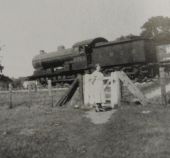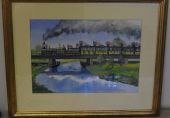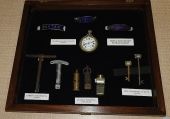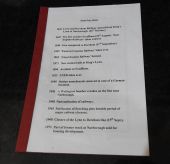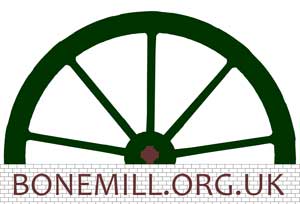Lynn to Dereham Railway talk by David Turner and David Burchell 3/11/2015
This was a fascinating talk and slideshow about the history of the railway which ran through Narborough, starting with the era before the railways came. The Marriotts of Narborough who owned The Maltings and river navigation rights as well as the warehouse in Kings Lynn protested hard to try to prevent railways coming to Norfolk and taking away their river trade. They were joined by many influential landowners of the time including Charles Tyssen, the owner of Narborough Hall and William Allen the vicar of Narborough. A petition was handed in to the Houses of Parliament objecting to the railway on grounds that it gave very little advantage compared to the interference it would cause to the many estates and farms affected. The railway companies fought back saying the Marriott’s had a monopoly and made excessive profits from it. When the railways eventually won, compensation was paid to those who had objected, and The Lodge at Narborough Hall (where David Turner was born) was built using the compensation money paid by the railway company.
On 26 October 1846 the railway from Kings Lynn to Downham Market, and Kings Lynn to Narborough was opened. The reason it terminated at Narborough was due to the extra work needed to cut through the chalk in Swaffham and continue on towards Dereham. We learned that the banks collapsed a few times and that chalk from the Swaffham cutting was used to build up the embankment at Narborough. The railway reached Swaffham in 1847 and Dereham in 1848. The railways were built by navvies and we saw a picture of one carrying his wheelbarrow on his back.
The slideshow included many old pictures of stations along the line, with many recent day pictures of the same location, with a particularly good selection of Narborough and Pentney station (as it was re-named) from 2003 when it was a private residence with well kept gardens, the platforms still visible. There were many pictures of our station when it was in use including the first diesel DMU to pass through in 1955. Of special interest to those of us associated with the bone mill were the pictures of the bridge showing the railway piers where we meet, and The Maltings showing the sidings which served the buildings.
The morning session ended with a film about the Lynn to Norwich line taken just before the closure of the passenger service. This showed the train leaving Kings Lynn and passing through Dunham, Fransham and Wendling then arriving at Dereham, showing the sidings serving businesses, engine shed and turntable. We learned that tracks remained in place until 1969 and were still used for freight traffic, the last freight train being in 1989.
There were many items put out on display for this talk, including a painting of the first train going over the bridge at Narborough, enamel hat badges, guards whistles, station masters watch, a model of Stevenson’s Rocket, picture of the 1894 Swaffham accident when a train fell down the bank, and many railway books and leaflets. We were given handouts containing key dates, an early railway map of Norfolk showing the many lines, and a detailed map of Narborough showing sidings to the goods shed and The Maltings.
After having an early lunch at the Community Centre we set off down the road to walk along the old railway track which is now a nature reserve open to the public. When we reached the road bridge David told us the reason for the dip in the road under it was to allow the railway to remain level. We walked along the footpath and could see how high the embankment is. As well as chalk from the Swaffham cutting, earth was dug from each side of the embankment to supplement it and give the height needed to carry the railway across the road and further along to give enough clearance to allow boats to pass under the river bridge. At the start of the nature walk we saw Sloes growing at the edge of the banks, Rosehips, and an Apple tree which we picked and found to be the eating variety, so many of us supplemented our lunch with them. At one place we found Toadstools and Ragwort, Daisies, Buttercups, Scabius, a few Poppies, Common Mallow, and Buckthorn berries. When we got to a bridge about half way along David told us that when he was young he used to call it a Catlarch, which he then explained meant cattle arch. There were good views of the countryside from all along the walk and it was a very enjoyable day.
Update: The view of the group walking down the field shows houses in Westfields, as this was before the new housing estates Sandy Road and Chalk Meadows were built.



